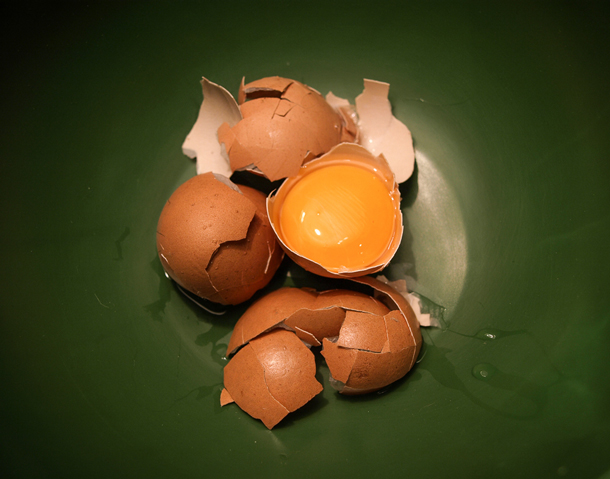BirdNote®: Recycle Your Egg Shells to Help Nesting Birds
Air Date: Week of May 24, 2019

Female Robins need to consume calcium in order to lay eggs. (Photo: © Justin Oliver)
Female birds need to eat calcium to have enough of the mineral to lay their eggs. But it can be hard to find enough in nature. We can help our backyard birds by offering them some extra calcium in bird feeders and by recycling our used chicken egg shells. BirdNote®’s Michael Stein explains.
Transcript
CURWOOD: It’s Living on Earth, I’m Steve Curwood.
[BIRDNOTE THEME]
Chickens put a lot of energy into producing strong egg shells and there are ways to reuse them. They can add calcium to compost, and in the garden, they are supposed to deter slugs. And as BirdNote’s Michael Stein reports, you can even recycle them for wild birds, especially in spring time.
BirdNote®
Recycle Your Eggshells to Help Nesting Birds
[American Robin song]
Birds’ eggs are among nature’s most elegant creations. But they’re not easy to make.
This American Robin will lay one egg per day for three to four days.
[American Robin call]
To make her eggs, the female robin has to use a great deal of calcium. But she can’t just pour herself a nice big glass of milk! She has to find her calcium in nature.

Dried chicken eggshells are a great source of calcium for nesting birds. (Photo: © Kevin O’Mara)
And it can be tough to find enough.
But we can help. During the nesting season, we can give the birds that visit our homes some of that crucial calcium.
Start off by putting calcium-enriched seed and suet in your bird feeders.
For the many species that don’t eat seed or suet—like robins—you can give them leftover chicken egg shells instead.
Rinse the shells off in the sink, spread them out on a cookie sheet, and bake them in the oven at about 250 degrees for ten minutes. You just want the shells to dry, not brown. When you’re done, crush them up.
Crushed eggshells can be mixed with birdseed and set out in a feeding tray or scattered right on the open ground.
And remember, always wash your hands after handling raw eggs.
[American Robin call]
###
Written by Bob Sundstrom
Producer: John Kessler
Managing Producer: Jason Saul
Editor: Ashley Ahearn
Associate Producer: Ellen Blackstone
Assistant Producer: Mark Bramhill
Narrator: Michael Stein
Bird sounds provided by The Macaulay Library of Natural Sounds at the Cornell Lab of Ornithology, Ithaca, New York. Recorded by Wil Hershberger.
BirdNote’s theme was composed and played by Nancy Rumbel and John Kessler.
© 2019 BirdNote May 2019
ID# egg-06-2019-05-14 egg-06
https://www.birdnote.org/show/recycle-your-eggshells-help-nesting-birds
Links
Living on Earth wants to hear from you!
Living on Earth
62 Calef Highway, Suite 212
Lee, NH 03861
Telephone: 617-287-4121
E-mail: comments@loe.org
Newsletter [Click here]
Donate to Living on Earth!
Living on Earth is an independent media program and relies entirely on contributions from listeners and institutions supporting public service. Please donate now to preserve an independent environmental voice.
NewsletterLiving on Earth offers a weekly delivery of the show's rundown to your mailbox. Sign up for our newsletter today!
 Sailors For The Sea: Be the change you want to sea.
Sailors For The Sea: Be the change you want to sea.
 The Grantham Foundation for the Protection of the Environment: Committed to protecting and improving the health of the global environment.
The Grantham Foundation for the Protection of the Environment: Committed to protecting and improving the health of the global environment.
 Contribute to Living on Earth and receive, as our gift to you, an archival print of one of Mark Seth Lender's extraordinary wildlife photographs. Follow the link to see Mark's current collection of photographs.
Contribute to Living on Earth and receive, as our gift to you, an archival print of one of Mark Seth Lender's extraordinary wildlife photographs. Follow the link to see Mark's current collection of photographs.
 Buy a signed copy of Mark Seth Lender's book Smeagull the Seagull & support Living on Earth
Buy a signed copy of Mark Seth Lender's book Smeagull the Seagull & support Living on Earth

